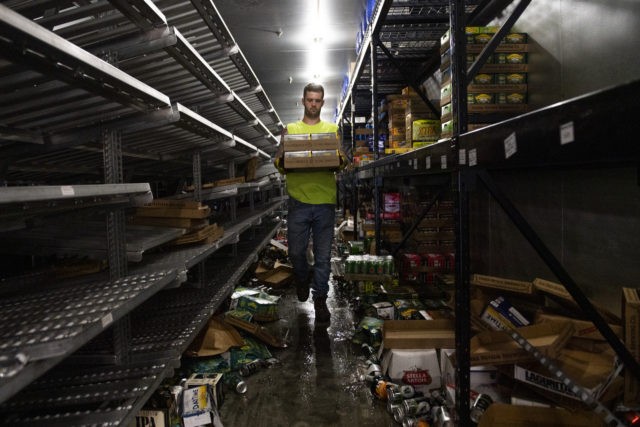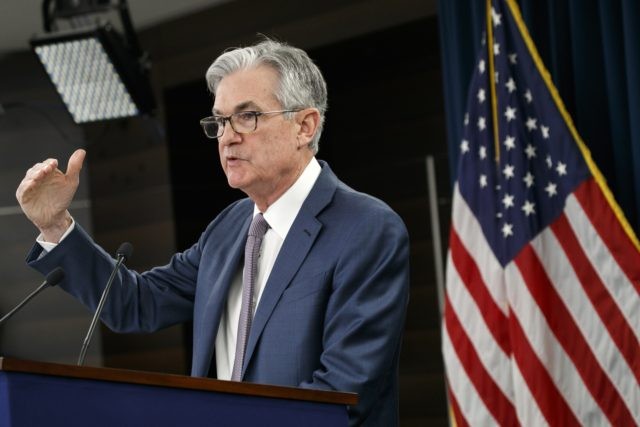Walmart to Lay Off Hundreds of Corporate Workers

Walmart Inc. is joining the ranks of Macy’s and L Brands in eliminating hundreds of corporate jobs in order to cut costs.
Employees in the mega-retailer’s store planning, logistics, and real estate units have reportedly received pink slips, reported Bloomberg Thursday:
Some of those affected were told in person, while others learned their fate over a Zoom call, said the people, who asked not to be identified because they aren’t authorized to speak publicly. Conversations with those impacted will continue throughout the week. Those who lose their jobs will be paid until the end of January, when Walmart’s fiscal year ends and annual bonuses get doled out, according to one of the people.
John Furner, director of Walmart’s U.S. operations, told Bloomberg that more information about the company’s restructuring would be forthcoming after communications with associates are completed.
“We are continuing on our journey to create an omni-channel organization within our Walmart U.S. business and we’re making some additional changes this week,” a spokesperson said, adding that efforts will seek to boost “innovation, speed and productivity.”
While Walmart’s sales during the coronavirus pandemic have surged, it is no longer opening new stores in the United States, and has been streamlining its operations for several years. Recently, it closed down its Jet.com e-commerce unit.
According to the report, Walmart’s stock climbed 10% this year through Wednesday, ahead of the S&P 500 index. However, it fell 1% to $129.38 per share Thursday morning in New York.
Layoffs are occurring in merchandizing, transportation, human resources, and product design, Bloomberg was told.
L Brands Inc., which owns Victoria’s Secret and Bath & Body Works, also announced this week it would be laying off 850 office workers, about 15 percent of its corporate staff.
Last month, Macy’s Inc. announced the elimination of 3,900 corporate and management positions as well.
The U.S. Economy Suffers Sharpest Downturn on Record

5:18
The U.S. economy shrank in the second quarter by the fastest rate since the government began keeping track of gross domestic product after World War II, as lockdowns aimed at curbing the coronavirus pandemic decimated economic activity and anti-police riots tore through many American cities.
Gross domestic product, or the value of all goods and services produced by the economy, contracted at a 32.9 percent seasonally adjusted annualized rate in the April through June three month period, according to the preliminary estimate from the Bureau of Economic Analysis published on Thursday. That marked the steepest drop on records stretching back to 1947 and compared with economists’ forecasts for a 35 percent decline in output.
The BEA reports the change in GDP on an annualized basis, which can exaggerate the impact of temporary and sudden shifts in the economy. Compared with both a year ago and with the first quarter of the year, GDP was down 9.5 percent.
The previous record decline on the standard, annualized basis was a 10 percent drop in the first quarter of 1958. The U.S. economy shrank at a 5 percent rate in the first three months of 2020.
Consumer spending crashed at an annualized rate of 34.6 percent in the quarter, led by a 43.5 percent annualized decline in spending on services. Consumer spending on goods fell at an annualized 11.3 percent. Private sector investment fell 49 percent, driven down by a 38.7 percent decline in residential investment, a 34.9 percent decline in commercial building investment, and a 37.7 percent decline in equipment investment.
Consumer spending on durable goods, which had been the worst hit segment of the economy in the early stages of the pandemic, declined a milder 1.1 percent.
In comparison to the year-ago period, the declines look less extreme. Consumer spending was down 10.7 percent. Spending on services dropped 14.7 percent. Spending on goods declined 1.8 percent. Private investment fell 17.9 percent.
Much of the economy was locked down during the second quarter, with only essential workers and services permitted to operate for work that could not be done from home. Americans were under instructions to stay home or social distance when in public. State reopenings required many businesses to operate at diminished capacity, limiting the speed of any rebound.
As well, businesses in cities across the U.S. found themselves under siege as protests turned into riots and looting. Although the total number of businesses that were damaged during the Black Lives Matter riots remains uncounted, that number certainly runs into the thousands.
In a separate report also released Thursday, the Department of Labor said that 1.43 million Americans filed initial claims for unemployment benefits last week, an increase of 12,000 from the week earlier. The virus and social distancing forced millions of employers to cut payrolls, throwing tens of millions of Americans out of work, as consumers slashed spending on travel, hotels, restaurants, and many other businesses. Yet as states have reopened their economies, employers have been hiring workers back at a record pace. An additional 4.8 million workers were added to payrolls in June and the unemployment rate fell to 11.1 percent.
The U.S. Census Bureau said in its latest weekly Household Pulse Survey that 51.1 percent of households experienced a loss of employment income in the week ended July 21, up from 48.3 percent four weeks ago.
Government relief efforts, however, gave a big boost to household income in the second quarter. Despite double-digit unemployment and the crash in consumer spending, personal income increased $1.39 trillion in the second quarter. The government said the increase in personal income was more than accounted for by an increase in government benefits. After-tax personal income increased $1.53 trillion, or 42.1 percent, in the second quarter. Real disposable personal income increased 44.9 percent.
Personal spending fell by $1.57 trillion. The contrast of rising income and falling spending drove up personal saving by $4.69 trillion in the second quarter. The personal saving rate—personal saving as a percentage of after tax personal income—was 25.7 percent in the second quarter, compared with 9.5 percent in the first quarter and 7.3 percent at the end of 2019.
Most analysts expect a sharp rebound in the current third quarter, covering the July through September period. Even still, the data is likely to show the economy contracted in 2020. So far the recovery has been less smooth than some analysts and many Trump administration officials expected. The housing sector has done well as the economy reopened but many other sectors, especially the labor market, have struggled or stalled.
Fed Sees Dim Economic Outlook as Pandemic Squeezes Economy

WASHINGTON (AP) — The Federal Reserve is expressing concern that the viral outbreak will act as a drag on the economy and hiring in coming months and that it plans to keep its benchmark short-term interest rate pegged near zero.
In a statement at the end of its policy-making meeting Wednesday, the Fed acknowledged that the economy has rebounded from the depths of March and April, when nearly all states closed down nonessential businesses. But it said the ongoing coronavirus pandemic “will weigh heavily on economic activity, employment and inflation.”
The Fed announced no new policies in its statement. The central bank said it will also continue to buy about $120 billion in Treasury and mortgage bonds each month, which are intended to inject cash into financial markets and spur borrowing and spending.
Economists say the Fed has time to consider its next policy moves because short- and long-term rates remain historically ultra-low and aren’t restraining economic growth. Home sales have picked up after falling sharply in the spring. The housing rebound has been fueled by the lowest loan rates on record, with the average 30-year mortgage dipping below 3% this month for the first time in 50 years.
With the economy struggling just to grow, small businesses across the country in serious danger and unemployment very high at 11.1%, few investors expect the Fed to hike interest rates for perhaps years to come. After its previous meeting last month, the Fed had signaled that it expected to keep its key short-term rate near zero at least through 2022.
Beginning in March, the Fed has slashed its short-term rate, bought more than $2 trillion in Treasury and mortgage bonds and unveiled nine lending programs to try to keep credit flowing smoothly.
Since the Fed’s previous meeting in June, the pandemic’s threat to the economy has appeared to worsen. The number of laid-off workers applying for unemployment aid has exceeded 1 million for 18 straight weeks. Measures of credit card spending have declined. And companies that track small-business employment say the number of people at work has leveled off, far below pre-pandemic levels, after having risen in May and June.
Most analysts say they think the Fed’s next move will be to provide more specific guidance about the conditions it would need to see before raising its benchmark short-term interest rate from zero.
Economists call such an approach “forward guidance,” and the Fed used it extensively after the 2008-2009 recession. Some Fed watchers expect no rate increase until 2024 at the earliest given the bleak outlook for the economy and expectations of continued ultra-low inflation. But by providing more certainty for investors about when a rate hike may occur, forward guidance can help keep longer-term rates lower than they might otherwise be.
The Fed will likely provide such guidance at its next meeting in September, economists say.
According to the minutes of their June meeting, “various” Fed officials felt it would “be important in the coming months … to provide greater clarity” about the future path of rates.
One potential form of forward guidance would be for the Fed to announce that it won’t raise rates until annual inflation has reached or exceeded its target of 2% for a specific period. This would be intended to allow inflation to rise above 2%, to offset inflation that has fallen below that target nearly continuously since 2012. (Inflation is now running at just 0.5%, according to the Fed’s preferred gauge.)
In recent speeches and appearances, Fed policymakers have sounded largely pessimistic about the economy. Several, including Powell, warned in late May, as many states began allowing more businesses to reopen, that a resurgent virus could imperil any recovery.
Congress is in the early stages of negotiating an economic relief package that might extend several key support programs, such as an expiring unemployment benefit that is now paying out $600 a week. That benefit will likely be reduced in any final legislation.
For now, the two parties are far apart, and the federal jobless benefit will likely lapse for about 30 million people who have been unemployed for several weeks. That would likely slow consumer spending and weaken the economy.
Susan Rice: 150,000 Dead Americans Is on Trump’s ‘Gross Mishandling of This Pandemic’
1:33
Wednesday on ABC’s “The View,” former Obama administration National Security Advisor Susan Rice said President Donald Trump was to blame for all the Americas who lost their lives in the coronavirus pandemic.
Rice said, “Anybody who knew anything about national security, global health, understood that a pandemic was inevitable. I write about it in my book that we were just talking about briefly at the outset. We prepared the incoming administration with a pandemic for dummies playbook. So the fault here, the tragic loss of 150,000 Americans and counting is on Donald Trump and his gross mishandling of this pandemic. He said it would go away. He likened it to the flu. He said, you know, that it would be fine to reopen our states prematurely. He’s encouraged kids to go back to school in communities where the virus is raging.”
She added, “Every step of the way Donald Trump has put his own personal political interests ahead of the health and well-being and the economic security of Americans. That is why this tragedy has been as bad as it has been, and if anybody has any doubt about that, look at many other competent countries in the rest of the world. In Europe, in Asia and elsewhere that have handled this in such a way that their kids are going back to school, their economies are reopening, and the numbers continue to go down. That is not what’s happening here.”
Follow Pam Key on Twitter @pamkeyNEN
No comments:
Post a Comment